
Back to Sidestreet Bannerworks
August 2001
Matheran 0-6-0T
by Marc Horovitz

India’s Matheran Hill Railway was built in 1905 to provide access to the resort of Matheran. It rises from Neral, near sea level, on the mainline near Bombay, to Matheran, elevation 2,500'. The journey took about two hours. The line is 12.5 miles long and has a ruling gradient of 1 in 30 (3%). There are many curves of 60' radius and one as tight as 45'. The consulting engineer was E.R. Calthrop, of Leek and Manifold fame, who specified 0-6-0T articulated locomotives with six-ton axle loading. Four locomotives were built to his specifications by Orenstein and Koppel in 1905-7. These engines had Klien-Lindner patented articulation.
There has been much discussion on the origins of the design of this articulation. As it appears on these locomotives, it is very close to the Heywood system. The center axle has sliding sideplay while the outer axles have radial movement. The trailing axle is behind the firebox, giving the engines a very long wheelbase. Externally, the engines do not appear to be articulated, as they have outside frames and, even on very sharp curves, it is difficult to see the sideways movement of the wheels and axles.
The four steam engines worked the line until the introduction of diesel power in 1956. The steam locos then worked with the diesels until the last one was withdrawn from active service in 1982. The railway still operates and it is thought that a Darjeeling B class 0-4-0ST has recently been transferred to Neral to work tourist trains. This makes a 100-year-old link with the past, as a B class tank engine was used on construction trains when the Matheran line was built.
All four engines survive today. One is at the Museum in Delhi, one is at Bombay, and one resides at Matheran. The fourth was brought into the UK in 1987 and was stored at Amberley and Peterborough. It is currently being restored for service at the Leighton Buzzard Light Railway in the UK. The boiler is now reunited with the chassis and it is hoped to have it back in steam in later in 2001. —D.B. Pinniger, Cookham, England
The model
Mike Gaskin is one of the lesser-known British handbuilders. His output is limited, which makes his products all the more delectable when one comes your way. His engines are workmanlike and reliable and each has its own particular charm.
His Matheran 0-6-0T is a sophisticated locomotive. It has an alcohol fired, locomotive-type boiler with a metal “arch” in the firebox. There’s a hand pump in the cab (with a large, removable handle), but no axle pump. Boiler fittings include a blower to help in raising steam, a throttle lever accessible through the left-hand window, a safety valve, a water glass with blowdown, and a pressure gauge. The displacement lubricator is mounted in the cab, above the boiler—an unusual position. The roof is removable for access to the controls.
The engine has working side tanks linked by a balance pipe under the boiler. The hand pump draws water from the tanks and can be used for the initial filling of the boiler. Cylinders are conventional double acting, D-valve, controlled by slip return cranks. Fuel is stored in a tank beneath the footplate that is filled via a pipe in the coal bunker behind the cab.
The most fun aspect of this locomotive, though, is that it sports the same type of Klien-Lindner articulation as the prototype. The center drum-axle can slide about 3/8" side to side on the inner driven axle. A spline transmits the power to the center wheels. The end wheels are mounted on spherical bearings that are splined to inner axles, allowing them to pivot about their center points. All axles are linked and work in conjunction with one another (see the photos). This articulation allows the engine to negotiate remarkably sharp curves, given its long wheelbase (6-5/8").
The engine was purchased by D.B. Pinniger in 1993, who christened it Sir Arthur, in homage to Sir Arthur Heywood. Heywood is thought to have come up with the first radial-axle design, though his was for a 15"-gauge locomotive. I acquired the engine several years ago.
Performance
After a careful oiling all around (especially all the moving parts between the axles) with a lightweight machine oil, I filled the lubricator with steam oil. The side tanks were filled with water and the boiler pumped up to just below the top nut of the glass. Fuel was added to the tank and a suction fan placed in the smoke stack to draw the draft through the boiler while pressure was being raised. I turned the fan on and lit the fire. In just a very few minutes 20 psi was showing on the gauge. I removed the fan and turned on the engine's blower. Pressure continued to rise rapidly. At 50 pounds I decided it was time to go. Water and meths were topped up and I turned off the blower and opened the throttle. With just a little coaxing, the engine took off.
Control of this engine is quite good. This is due in part to the design of the throttle and in part to its placement near the cab window. Slow-speed running is no problem (nor is high-speed running!). However, it's an engine that cannot be ignored and left to its own devices. You must keep a constant eye on the water level and make sure the fuel is topped up as well. With occasional stops for feeding and watering, the loco can be kept in steam indefinitely. After the cylinders were warm, it would easily self start whenever the throttle was opened.
Because it is a big engine with a narrow stance, and because of its suspension system (stability is mostly ensured by the arrangement of the center axle), the loco has a strange rocking, or waddling, gait, unlike any other locomotive I've seen. This adds to its charm, to my way of thinking. It looks great traversing my railway, circuit after circuit, with the occasional puff of blue smoke as a little oil enters the smokebox from the cylinders.
I ran the engine for about 45 minutes before the heat of the day drove me back indoors. The hand pump developed a leak—probably the packing—toward the end of the run and made a mess of the wooden cab floor, but it will dry out. Even though it leaked, the pump still worked.
I dropped the fire (blew down the smokestack through a tube that I keep handy for that purpose) and opened the blowdown, both to drain the boiler and to release the resulting vacuum as the boiler cooled. I used a syringe to suck the remaining water out of the side tanks and left the lids off so the interior could dry out. This is a very satisfying locomotive to operate. It is sophisticated, but not too tricky, and performs wonderfully.
This locomotive was covered in an extensive article by the builder in the March 2000 issue of the British magazine, GardenRail.
| Specifications | |
| Builder | Mike Gaskin (Great Britain) |
| Date built | Circa 1991 |
| Gauge | 32mm (gauge 0) |
| Scale | 16mm |
| Boiler | Locomotive type with cross tubes in the firebox |
| Fittings | Safety valve, throttle, blower, pressure gauge, water glass, blowdown, hand pump |
| Fuel | Alcohol |
| Blow-off pressure | 75 psi |
| Cylinders | Two, double acting, D-valve |
| Reversing gear | Slip return cranks |
| Lubricator | Displacement, in the cab |
| Dimensions | Length over buffer beams, 13-1/4"; width, 4-3/4"; height over stack, 5-7/8" |
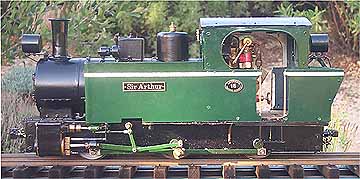
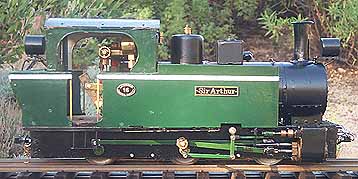
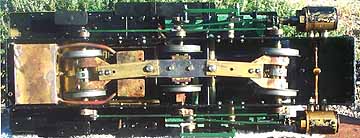
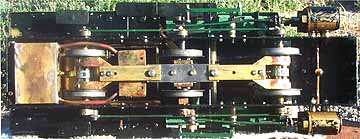
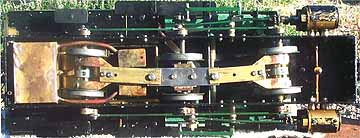

Right. The hand pump in the cab. The unsightly handle is removable.



Back to Sidestreet Bannerworks
This page and its contents Copyright Sidestreet Bannerworks, 2001